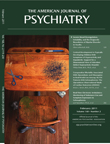In this issue, Swendsen and colleagues (
1) report that substance use, mood states, and psychotic symptoms in schizophrenia patients can be measured in real time. The findings in this article offer a new strategy for investigating cause-and-effect relationships between environmental influences and psychopathology.
Early support for a link between substance use and psychosis onset came from a 15-year follow-up of Swedish conscripts, which found that heavy cannabis use was related to an increased risk for schizophrenia (
2). Subsequent cohort studies have similarly reported that the use of cannabis and other “street drugs” increases the risk of psychosis onset (
3,
4). In turn, several groups have explored the question of whether substances are used as an attempt to self-medicate psychotic symptoms or to alleviate dysphoria, but the results of such studies have been mixed (
5,
6).
An inherent limitation to this literature is that it is usually necessary to rely on retrospective self-report and clinical assessments for data collection. Moreover, in a population of patients with known impairments in episodic memory (
7), the reliability of retrospective clinical data may be particularly limited. Thus, the use by Swendsen and colleagues of computerized ambulatory monitoring techniques to assess temporal relationships between subjective experiences and events offers a novel and powerful new strategy to study behaviors and their motivation in real time. Similar studies have been conducted by this group to study alcohol use (
8) and other aspects of the syndrome of schizophrenia (
9).
Swendsen and colleagues (
1) used computerized ambulatory monitoring to record alcohol or drug use and psychotic symptoms and mood states in 145 schizophrenia patients. The schizophrenia patients were trained to use a personal digital assistant (PDA) to complete 15-minute electronic interviews, and the PDAs were programmed to prompt the participant four times each day (between 9:00 a.m. and 9:00 p.m.) for 1 week. The study findings revealed that the use of cannabis increased the risk of experiencing psychotic symptoms, while decreasing perceived negativity. In contrast, the use of alcohol was not temporally associated with the risk of experiencing psychotic symptoms or negative mood states. The use of “other” substances (e.g., cocaine, opiates, amphetamines) also increased the risk of experiencing psychotic symptoms or anxiety. Finally, Swendsen and colleagues completed the circle of cause and effect by showing that the presence of psychotic symptoms was related to later use of alcohol or other drugs, while anxiety, sadness, and perceiving events as negative were related to the later use of alcohol, cannabis, and other illicit drugs. Drilling deeper into each of these temporal relationships revealed specific relationships between different psychopathological states and substances.
The authors appropriately controlled for the status of predicted outcomes as they existed at the moment the predictor variable was assessed. They also controlled for other confounds, such as time of day, medication use, and polysubstance use. As noted by the authors, the conclusions that can be drawn from this study are somewhat limited because of the lack of data on the frequency and duration of substance use. Moreover, the findings may also be less applicable to schizophrenia patients with more severe negative symptoms, as such patients may have been more likely to decline participation and more likely to refuse completion once participation began. Last, given that substance use can peak during the evening hours, it would be interesting in future studies to examine the use of substances and negative outcomes at time points later than the 9:00 p.m. limit used in the current study.
Despite these minor limitations, this study has substantial clinical and methodological importance. First, the ability to measure hourly fluctuations in substance use, psychosis, and negative mood states can help advance our knowledge of the temporal relationships among events, behavior, and internal experience. The results of this study provide support for the growing consensus that cannabis and perhaps other drugs can trigger psychotic symptoms. In turn, the results of this study also provide support for prior claims of self-medication for dysphoria (
10), since cannabis and alcohol use followed the experience of psychotic symptoms and negative mood states. In sum, it appears that the “arrow” of cause and effect is circular and points back onto itself. Second, the authors have further validated the use of computerized ambulatory monitoring techniques for collecting real-time data in a challenging clinical population. This technique could potentially be extended to estimate the quantity, frequency, and duration of a variety of behaviors and internal psychological states in many other groups of patients. Moreover, it could be utilized in the context of treatment to better understand adherence to, and the effects of, psychotropic medications on an hourly or daily basis.
Nearly 50% of schizophrenia patients have a lifetime diagnosis of a comorbid substance use disorder (
11). Thus, new interventions are badly needed to reduce the motivation of schizophrenia patients to use drugs and to reduce the effects of such drugs on internal experience and behavior. The work presented in this issue by Swendsen and colleagues (
1) demonstrates that the use of a novel technique, computerized ambulatory monitoring, is feasible and can be used to unravel relationships between substance use, experience, and psychopathology. Beyond the use of such technology in clinical research, it is tantalizing to think that computerized ambulatory monitoring might find a role in the clinic one day. What clinician has not struggled to understand the event or thought that preceded an action in a patient? Real-time ambulatory monitoring offers a new strategy for reaching out to our patients and for our patients to reveal their experiences to us.

